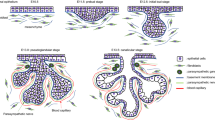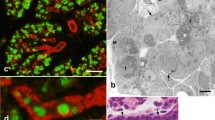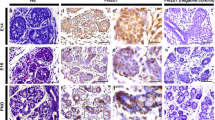Abstract
Fibroblast growth factors (FGFs) and their receptors (FGFRs) play important roles in the development of the submandibular gland. Although regeneration of submandibular glands follows a similar process to their development, it is unknown how FGFs and FGFRs are distributed during regeneration of submandibular gland. The aim of this study was to determine the localization of FGFs and FGFRs during such regenerative processes. After 7 days’ obstruction, the submandibular glands were collected at days 0, 1, 3, 7, 11 and 14 after duct release to study regeneration. The regenerative processes of the submandibular gland were investigated by immunohistochemistry for FGF-2, 7, 8, 10 and FGFR-1–4. Immunohistochemical staining revealed that FGF-2 was moderately expressed in the epithelial cells of duct-like structures (DLS) and newly formed acinar cells (NFAC) at days 0–7, and strongly in intercalated duct (ICD) at control gland and Day 7–14. FGF-7 was localized moderately in NFAC and DLS. FGF-8 was localized moderately in the epithelial cells of DLS during regeneration. Strong positive immunoreactions for FGF-10 were found in NFAC and the epithelial cells of DLS during regeneration, as well as the ICD and lateral surfaces of the maturing acinar cells (MAC). FGFR-1 was expressed moderately in the ICD, and weakly in the NFAC and MAC. Positive immunoreactions for FGFR-2 were not observed during regeneration. Additionally, FGFR-4 was detected strongly in the ICD and slightly in NFAC. These findings suggest that FGF-2, -7, -8 and -10 play important roles in NFAC, MAC, and DLS through FGFR-1 and -4 during regeneration of submandibular gland.



Similar content being viewed by others
References
Amano O, Yoshitake Y, Nishikawa K, Iseki S (1993) Basic fibroblast growth factor in rat salivary glands. Cell Tissue Res 273:467–474. doi:10.1007/BF00333701
Aure MH, Ruus AK, Galtung HK (2014) Aquaporins in the adult mouse submandibular and sublingual salivary glands. J Mol Histol 45:69–80. doi:10.1007/s10735-013-9526-3
Bhaskar SN, Lilly GE, Bhussry B (1966) Regeneration of the salivary glands in the rabbit. J Dent Res 45:37–41. doi:10.1177/0022034566045001260
Burgess KL, Dardick I, Cummins MM, Burford-Mason AP, Bassett R, Brown DH (1996) Myoepithelial cells actively proliferate during atrophy of rat parotid gland. Oral Surg Oral Med Oral Pathol Oral Radiol Endod 82:674–680. doi:10.1016/S1079-2104(96)80443-4
Celli G, LaRochelle WJ, Mackem S, Sharp R, Merlino G (1998) Soluble dominant-negative receptor uncovers essential roles for fibroblast growth factors in multi-organ induction and patterning. EMBO J 17:1642–1655. doi:10.1093/emboj/17.6.1642
Colvin JS, Bohne BA, Harding GW, McEwen DG, Ornitz DM (1996) Skeletal overgrowth and deafness in mice lacking fibroblast growth factor receptor 3. Nature Genet 12:390–397. doi:10.1038/ng0496-390
De Moerlooze L, Spencer-Dene B, Revest J-M, Hajihosseini M, Rosewell I, Dickson C (2000) An important role for the IIIb isoform of fibroblast growth factor receptor 2 (FGFR2) in mesenchymal-epithelial signalling during mouse organogenesis. Development 127:483–492
Deng CX, Wynshaw-Boris A, Shen MM, Daugherty C, Ornitz DM, Leder P (1994) Murine FGFR-1 is required forearly postimplantation growth and axial organization. Genes Dev 8:3045–3057. doi:10.1101/gad.8.24.3045
Deng C, Wynshaw-Boris A, Zhou F, Kuo A, Leder P (1996) Fibroblast growth factor receptor 3 is a negative regulator of bone growth. Cell 84:911–921. doi:10.1016/S0092-8674(00)81069-7
Guo L, Yu Q-C, Fuchs E (1993) Targeting expression of keratinocyte growth factor to keratinocytes elicits striking changes in epithelial differentiation in transgenic mice. EMBO J 12:973–986
Guo L, Degenstein L, Fuchs E (1996) Keratinocyto growth factor is required for hair development but not for wound healing. Genes Dev 10:165–175. doi:10.1101/gad.10.2.165
Hamada T, Suda N, Kuroda T (1999) Immunohistochemical localization of fibroblast growth factor receptors in the rat mandibular condylar cartilage and tibial cartilage. J Bone Miner Metab 17:274–282. doi:10.1007/s007740050095
Hanks CT, Chaudhry AP (1971) Regeneration of rat submandibular gland following partial extirpation. A light and electron microscopic study. Am J Anat 130:195–207. doi:10.1002/aja.1001300206
Hiramatsu Y, Kagami H, Kosaki K, Shigetomi T, Ueda M, Kobayashi S, Sakanaka M (1994) The localization of basic fibroblast growth factor (FGF-2) in rat submandibular glands. Nagoya J Med Sci 57:143–152
Hiramatsu Y, Kagami H, Horie K, Okazaki Y, Shigetomi T, Hata K, Kobayashi S, Ueda M (2000) Effects of basic fibroblast growth factor on cultured rat and human submandibular salivary gland cells. Arch Oral Biol 45:593–599. doi:10.1016/S0003-9969(99)00148-x
Hoffman MP, Kidder BL, Steinberg ZL, Lakhani S, Ho S, Kleinman HK, Larsen M (2002) Gene expression profiles of mouse submandibular gland development: FGFR1 regulates branching morphogenesis in vitro through BMP- and FGF-dependent mechanisms. Development 129:5767–5778. doi:10.1242/dev/00172
Igarashi M, Finch PW, Aaronson SA (1998) Characterization of recombinant human fibroblast growth factor (FGF)-10 reveals functional similarities with keratinocyte growth factor (FGF-7). J Biol Chem 273:13230–13235. doi:10.1074/jbc.273.21.13230
Itoh N, Ornitz DM (2004) Evolution of the Fgf and Fgfr gene families. Trends Genet 20:563–569. doi:10.1016/j.tig.2004.08.007
Jaskoll T, Zhou YM, Chai Y, Makarenkova HP, Collinson JM, West JD, Hajihosseini MK, Lee J, Melnick M (2002) Embryonic submandibular gland morphogenesis: stage-specific protein localization of FGFs, BMPs, Pax6 and Pax9 in normal mice and abnormal SMG phenotypes in FgfR2-IIIc(+/Delta), BMP(−/−) and Pax6(−/−) mice. Cells Tissues Org 170:83–98. doi:10.1159/000046183
Jaskoll T, Witcher D, Toreno L, Bringas P, Moon AM, Melnick M (2004) FGF8 dose-dependent regulation of embryonic submandibular salivary gland morphogenesis. Dev Biol 268:457–469. doi:10.1016/j.ydbio.2004.01.004
Jaskoll T, Abichaker G, Witcher D, Sala FG, Bellusci S, Hajihosseini MK, Melnick M (2005) FGF10/FGFR2b signaling plays essential roles during in vivo embryonic submandibular salivary gland morphogenesis. BMC Dev Biol 5:11. doi:10.1186/1471-213X-5-11
Kinkl N, Hageman GS, Sahel JA, Hicks D (2002) Fibroblast growth factor receptor (FGFR) and candidate signaling molecule distribution within rat and human retina. Mol Vis 8:149–160
Kusafuka K, Tamaguchi A, Kayano T, Takemura T (1998) Immunohistochemical localization of fibroblast growth factors (FGFs) and FGF receptor-1 in human normal salivary glands and pleomorphic adenomas. J Oral Pathol Med 27:287–292. doi:10.1111/j.1600-0714.1998.tb01958.x
Li C, Xie X, Wang X, Sun Y, Liu P, Chen L, Qin C (2013) Differential expression and localization of dentin matrix protein 1 (DMP1) fragments in mouse submandibular glands. J Mol Histol 44:231–239. doi:10.1007/s10735-012-9464-5
MacArthur CA, Lawshé A, Xu J, Santos-Ocampo S, Heikinheimo M, Chellaiah AT, Ornitz DM (1995) FGF-8 isoforms activate receptor splice forms that are expressed in mesenchymal regions of mouse development. Development 121:3603–3613
Madan AK, Kramer B (2005) Immunolocalization of fibroblast growth factor-2 (FGF-2) during embryonic development of the rat submandibular gland. SADJ 58:60–61
Ohuchi H, Hori Y, Yamasaki M, Harada H, Sekine K, Kato S, Itoh N (2000) FGF10 acts as a major ligand for FGF receptor 2 IIIb in mouse multi-organ development. Biochem Biophys Res Commun 277:643–649. doi:10.1006/bbrc.2000.3721
Okazaki Y, Kagami H, Hattori T, Hishida S, Shigetomi T, Ueda M (2000) Acceleration of rat salivary gland tissue repair by basic fibroblast growth factor. Arch Oral Biol 45:911–919. doi:10.1016/S0003-9969(00)00035-2
Ornitz DM, Xu J, Colvin JS, McEwen DG, MacArthur CA, Coulier F, Gao G, Goldfarb M (1996) Receptor specificity of the fibroblast growth factor family. J Biol Chem 271:15292–15297. doi:10.1074/jbc.271.25.15292
Patel VN, Likar KM, Zisman-Rozen S, Cowherd SN, Lassiter KS, Sher I, Yates EA, Turnbull JE, Ron D, Hoffman MP (2008) Specific heparan sulfate structures modulate FGF10-mediated submandibular gland epithelial morphogenesis and differentiation. J Biol Chem 283:9308–9317. doi:10.1074/jbc.M709995200
Powers CJ, McLeskey SW, Wellstein A (2000) Fibroblast growth factors, their receptors and signaling. Endocr Relat Cancer 7:165–197. doi:10.1677/erc.0.0070165
Qiao J, Uzzo R, Obara-Ishihara T, Degenstein L, Fuchs E, Herzlinger D (1999) FGF-7 modulates ureteric bud growth and nephron number in the developing kidney. Development 126:547–554
Sekine K, Ohuchi H, Fujiwara M, Yamasaki M, Yoshuzawa T, Sato T, Yagishita N, Matsui D, Koga Y, Itoh N, Kato S (1999) Fgf10 is essential for limb and lung formation. Nature Genet 21:138–141. doi:10.1038/5096
Shimizu O, Shiratsuchi H, Ueda K, Oka S, Yonehara Y (2012) Alteration of the actin cytoskeleton and localization of the α6β1 and α3 integrin during regeneration of the rat submandibular gland. Arch Oral Biol 57:1127–1132. doi:10.1016/j.archoralbio.2012.02.018
Steinberg Z, Myers C, Heim VM, Lathrop CA, Rebustini IT, Stewart JS, Larsen M, Hoffman MP (2005) FGFR2b signaling regulates ex vivo submandibular gland epithelial cell proliferation and branching morphogenesis. Development 132:1223–1234. doi:10.1242/dev.01690
Takahashi S, Shinzato K, Nakamura S, Domon T, Yamamoto T, Wakita M (2004) Cell death and cell proliferation in the regeneration of atrophied rat submandibular glands after duct ligation. J Oral Pathol Med 33:23–29. doi:10.1111/j.1600-0714.2004.00191
Ueda K, Shimizu O, Oka S, Saito M, Hide M, Matsumoto M (2009) Distribution of tenascin-C, fibronectin and collagen types III and IV during regeneration of rat submandibular gland. Int J Oral Maxillofac Surg 38:79–84. doi:10.1016/j.ijom.2008.11.004
Wang X, Qi S, Wang J, Xia D, Qin L, Zheng Z, Wang L, Zhang C, Jin L, Ding G, Wang S, Fan Z (2014) Spatial and temporal expression of c-Kit in the development of the murine submandibular gland. J Mol Histol 45:381–389. doi:10.1007/s10735-014-9570-7
Xu X, Li C, Takahashi K, Slavkin HC, Shum L, Deng C-X (1999) Murine fibroblast growth factor receptor 1a isoforms mediate node regression and are essential for posterior mesoderm development. Dev Biol 208:293–306. doi:10.1006/dbio.1999.9227
Yeh BK, Igarashi M, Eliseenkova AV, Plotnikov AN, Sher I, Ron D, Aaronson SA, Mohammadi M (2003) Structural basis by which alternative splicing confers specificity in fibroblast growth factor receptors. Proc Natl Acad Sci USA 100:2266–2271. doi:10.1073/pnas.0436500100
Yin SJ, Tang XB, Li FF, Tao Zhang, Yuan ZW, Wang WL, Bai YZ (2013) Spatiotemporal expression of fibroblast growth factor 10 in human hindgut and anorectal development. Cell Tissues Org 198:28–34. doi:10.1159/000351472
Acknowledgments
This work was supported by JSPS KAKENHI Grant No. 24593011 and a Grant from the Dental Research Center and Sato Fund, Nihon University School of Dentistry.
Author information
Authors and Affiliations
Corresponding author
Rights and permissions
About this article
Cite this article
Shimizu, O., Yasumitsu, T., Shiratsuchi, H. et al. Immunolocalization of FGF-2, -7, -8, -10 and FGFR-1–4 during regeneration of the rat submandibular gland. J Mol Hist 46, 421–429 (2015). https://doi.org/10.1007/s10735-015-9631-6
Received:
Accepted:
Published:
Issue Date:
DOI: https://doi.org/10.1007/s10735-015-9631-6




